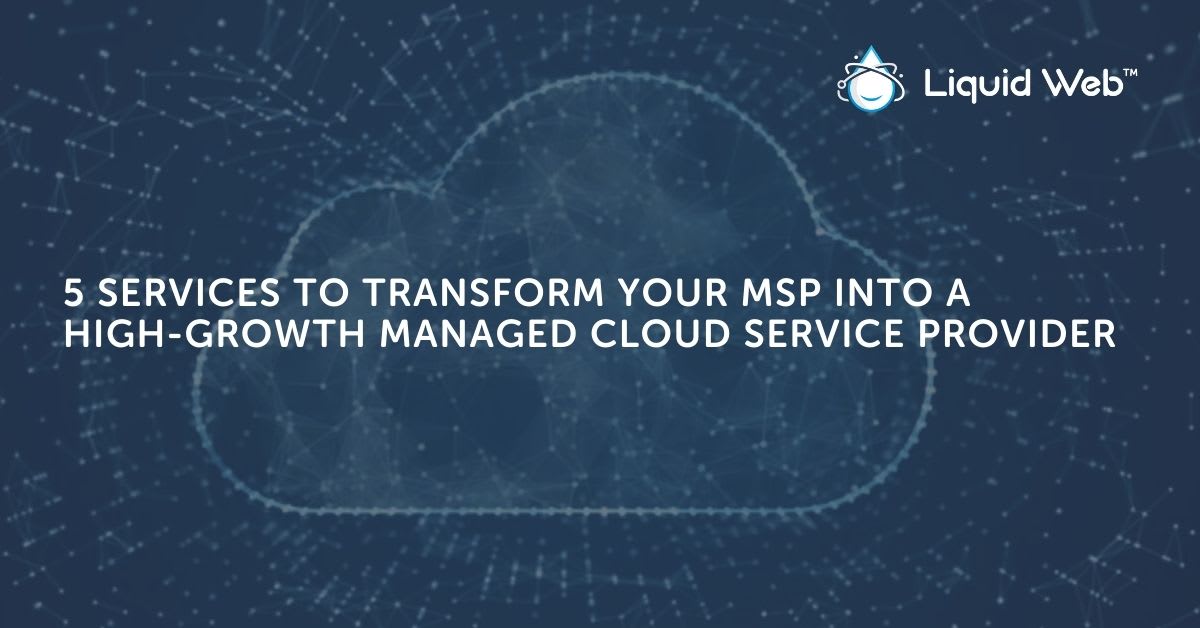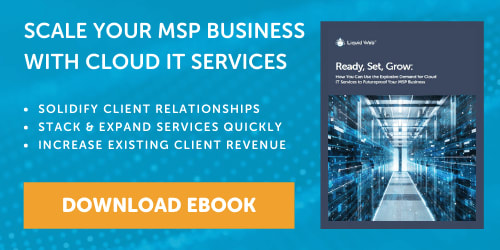
Keeping up with the global digital transformation, the evolving needs of remote employees, and advanced security threats is challenging. Business agility, efficiency, and responsiveness necessitate a dependency on managed cloud service providers to not only survive but thrive.
For managed service providers (MSPs), staying ahead of this move to the cloud and the increasingly sophisticated nature of client demands is complicated, requiring them to change their approach. While it may seem daunting, the opportunities for your business are tremendous.
Key Differences Between a Managed Service Provider vs Managed Cloud Service Provider
| Managed Service Provider (MSP) | Managed Cloud Service Provider (MCSP) |
|---|---|
| On-Premises Products and Services | Cloud Service Models: Software-as-a-Service (SaaS) Infrastructure-as-a-Service (IaaS) Platform-as-a-Service (PaaS) |
| IT Operations and Network Performance/Availability | Develop Innovative Strategies to Meet Business and IT Needs |
| Individual Products and Services to Solve a Single Problem | Products and Services are Combined to Meet Objectives Across an Organization |
| Immediate or Short-term Client Needs | Long-Term Approach to Meeting Clients’ Business Goals |
The Traditional Role of a Managed Service Provider or MSP
MSPs have traditionally focused on IT equipment maintenance and replacement, system administration, infrastructure management, telecom services, incident response, end-user onboarding, patch management, reporting, and other supporting responsibilities. It is a tactical technology role rather than a strategic partnership role.
Products and services like software licenses, server hardware, and data backup solutions are sold as individual commodities. Since these products are developed by third-party vendors who sell them across the MSP community, there is little differentiation between MSPs.
Since managed service providers are already managing specific areas of IT operations, they are in the perfect position to help. Still, the cloud requires new expertise and a new way of thinking about their clients’ business.
Transforming your MSP into a managed cloud service provider will position you for success.
What is a Managed Cloud Service Provider (MSCP)?
A managed cloud service provider offers an IT model where all software, infrastructure, platform, and storage resources are delivered in the cloud. This enables clients to purchase only the services they need and pay for only the services used.
A managed cloud service provider is an expert in using cloud technology to help a customer achieve the best business advantage. This requires a broader understanding of all aspects of a business across all departments.
A managed cloud service provider can:
- Improve efficiencies and implement cost controls.
- Enable flexibility.
- Improve scalability.
- Enhance agility.
- Ensure best practices are adhered to.
- Deliver security and availability.
Why Make the Transition to Managed Cloud Service Provider?
The role of the successful MSP is evolving from on-premises hardware and software management, equipment replacement, and server maintenance to cloud-based information management focused on business continuity, all-in-one solutions, employee education, enhanced productivity measures, and advanced threat protection.
Clients are looking for their MSP to provide company-wide value and deliver tactical and strategic IT results that impact business efficiency, productivity, and profitability. They have moved beyond simply requiring break-fix services or on-premises network maintenance. They need custom solutions, more meaningful business relationships, scalable infrastructure, and advanced security.
As a result, the new age of the managed cloud service provider requires the development of reliable and secure cloud-based workloads to meet changing company, customer, employee, and market demands.

5 Benefits of Moving from a Managed Service Provider to a Managed Cloud Services Provider
You can use these five managed cloud service areas to grow a successful managed cloud service provider business:
1. Security
With ever-evolving and increasingly sophisticated security threats, organizations require a specialist in cloud security. Breaches as a result of today’s web security problems reduce profitability, decrease revenue from potential customers, and damage the organization’s reputation. Both small businesses and large enterprises no longer have the expertise, resources, or infrastructure to manage their company’s security requirements on their own.
A managed cloud service provider is a cloud security specialist with an on-staff team of security professionals. As such, your business can maintain a highly secure and easily scalable infrastructure specifically designed and maintained to resist a wide variety of advanced attacks.
2. Data Migration
Data is a valuable and highly competitive company asset. But the vast quantities of data that companies produce daily are growing dramatically beyond management’s control. Organizations determined to tackle out-of-control data are engaging managed cloud service providers to identify where critical information is stored and who can access it. They are also interested in cloud migration using a managed cloud infrastructure to ensure data is easily accessible, always available and protected with multiple redundancy levels and business continuity measures.
3. Strategic Cloud Solutions
With so many cloud service options readily available, many businesses have attempted to implement a cloud-based IT strategy on their own. They now realize that selecting and coordinating the perfect combination of cloud services, understanding current usage needs, and anticipating future growth requirements is more challenging than expected. It requires a managed cloud service provider who can structure a company-wide solution that frequently includes a hybrid approach. That means meeting both technology requirements and business goals.
4. Compliance
Businesses in heavily regulated industries like financial services, legal, and healthcare struggle to keep up with compliance requirements and configure an IT solution that meets changing regulations as well as mitigates security risks. A managed cloud service provider can remove the burden of managing the company’s IT infrastructure in the cloud and ensure that the business meets mandatory compliance standards.
5. Strategic IT Efficiencies
Successful IT management is more than proactive equipment maintenance and user email access. It’s about digital transformation that requires an investment in enhanced efficiencies across the organization. The new world of remote work, changing customer demands, and the ongoing need to stay competitive means that digital technology must be evaluated holistically across an organization.
Digital technology evaluation should include:
- Automation, unification, and streamlining of IT processes.
- Application integration.
- Data storage.
- Information analysis.
The ability to combine cloud-based efficiencies with traditional managed IT services, advanced security measures, enhanced customer support, and business continuity enables managed cloud service providers to offer a highly lucrative end-to-end cloud solution. It demonstrates a strategic focus on future business growth instead of individual technologies or vendor selection.
This transition to cloud services and the realization that technology solutions can have a significant and positive impact on future growth is causing organizations to seek out those managed cloud service providers positioned to help guide their complete IT strategy.
The addition of security, data migration, and compliance are undoubtedly critical elements in a successful managed cloud service provider’s portfolio of services. But developing the specialization and infrastructure to support your clients adequately will take time, money, and resources if you attempt it on your own.

Implementing a Managed Cloud Services Model in Your Business
Here are five practical ways to begin your business evolution from a traditional MSP to a managed cloud service provider:
1. Transform Your Sales Strategy
Begin transforming your sales strategy from selling individual products and services to business-focused solution selling. Rather than selling a standalone commodity service sold by many MSPs, focus on selling a solution that helps a client meet a business need.
Selling all-in-one solutions enables you to differentiate yourself, add value to your offering, and become a trusted advisor in your clients’ eyes.
2. Cloud Training
Does your current managed services team have the skills to transition to a cloud environment, or will you need to hire additional personnel? Not only will engineers need to be retrained, but your sales team will need to understand the complexities of solutions architecture. Threat management and mitigation, as well as current security trends and advanced technologies, also require initial and ongoing training.
3. Enable Automated Infrastructure Monitoring and Billing
Automated infrastructure monitoring and billing are critical in a cloud environment because they allow you to track service usage across your client base and enable each of your clients to assess precisely the services they use. That means they will not be billed for services that have gone unused for some time and prevent them from being hit with unanticipated expenses.
4. Establish a Service-Level Agreement (SLA)
A service-level agreement is your assurance to your clients regarding the level of service you will provide and what they should expect from you. It demonstrates your high level of commitment, expertise, and accountability and provides your clients with peace of mind that you have their business, security, and technology objectives as top priorities.
5. Assess Requirements to Meet Industry Standards and Receive Certifications
SSAE, CSA, HIPAA, NIST, PCI, and other standards organizations and quality frameworks provide best practices and benchmarks by which cloud service providers are judged. Potential clients evaluating a shortlist of managed cloud service providers will want to know that you meet many of these guidelines and standards.
As these certifications take time to receive, it is essential to start early evaluating their requirements and the changes you need to make to your organization and operations to accomplish this objective and become certified.
6 Best Practices to Maintain and Successfully Run Your Managed Cloud Service Provider Business
Use this list of six best practices to maintain the hard work you have invested in your managed cloud service provider business:
1. Create Comprehensive Provider and Client Security Policies
Clients want to feel confident that the quality of the security measures you put in place for them are as secure as a solution you would put in place to protect our own business, employees, and data. Managed cloud service provider and client systems and data security policies should be the most current, working properly, tested, and evaluated regularly.
2. Complete Ongoing Compliance Audits
An independent third-party audit must occur yearly to meet compliance requirements. In addition, the completed audit report should be made available to clients and potential clients upon request to demonstrate both your managed cloud service provider compliance and transparency.
3. Maintain an Online Reporting Portal
Clients want to periodically assess what IT services they are using, how each service is performing, and what they pay. Maintaining an online management and reporting portal enables your clients to evaluate their services on-demand.
4. Utilize Standard Integration Interfaces
The use of a hybrid cloud environment requires integration between a client’s infrastructure and the cloud. As a result, standard APIs and other integration interfaces should be used to ensure a reliable and always available connection for employees and other users.
5. Implement Infrastructure Redundancies and Data Backups
Business continuity and disaster recovery are essential for today’s modern business. Implement server, application, and database replication policies and procedures and install redundant infrastructure resources to maintain always-on availability. Also, ensure you can immediately restore client backups in the event of a disaster or any type of outage.
6. Provide Cloud Migration Support
Cloud migration enables organizations to grow into a cloud environment while still working within their existing infrastructure without impacting their availability, employee access, or customers’ ability to make purchases. Your ability to provide a smooth transition without business interruption is a critical element in your successful transition to a managed cloud service provider.
Offer Your Clients Managed Cloud Infrastructure Solutions with Liquid Web
Whether you choose a VMware Private Cloud, High Availability Environment, or a HIPAA Compliant solution, Liquid Web merges exceptional partner support with an extensive technology portfolio, an established cloud infrastructure, fully managed IT operations, and advanced multilevel security. We deliver the efficiencies and service portfolio you demand with the robust cloud environment your customers require.
[ad_2]
Source link







